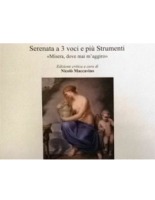Gagliarda e Sonata a Tre – Secondo Tuono. For 2 violins (recorders in c), bass instrument (ad lib.) and basso continuo. Edited by Franz Müller-Busch. Realization of the thorough bass by Yo Hirano
TURINI Gagliarda e Sonata a Tre, Secondo Tuono. Per 2 violini (flauti dolci in do), basso e bc. Girolamo Verlag
€27.50
Preface
Francesco Turini was born around 1589 in Prague, where he received tuition in organ, singing and composition from his father, Gregorio. At the early age of 12, he became court organist to Emperor Rudolf II, who later sent him on a study trip to Rome and Venice. Turini lived in Prague until the death of Rudolf II in 1612 and then returned to Italy, where he first worked in Venice and Padua. In 1620, he was appointed cathedral organist in Brescia, a post he held until his death in 1656
The two pieces at hand are taken from a print published in 1624, now held in the Austrian National Library. The four part books are entitled:
Madrigali / a una, due, e tre voci / con alcune Sonate / a due, et a tre / Libro Primo. /
Di Francesco Turini / Organista del Duomo di Brescia. /
Novamente ristampato, & corretto, Con l’Aggiunta d’alcuni /
Madrigali, & Sonate che nella prima Stampa / non vi sono. /
Con Privilegio / In Venetia / Appresso Alessandro Vincenti. MDCXXIIII.
In actual fact, the print of this opus by Turini that was published by Bartolomeo Magni in 1621, and in a second edition in 1624, does not include the two pieces published here. The four other pieces in the print are available from Girolamo as editions no. G 12.017 and no. G 12.019.
In the six purely instrumental pieces included, the two upper parts are marked “violino”. Their range and musical idiom are such that they can easily be played on other instruments, for example recorders in C. The “basso continuo” part contains the typical, rather sparse figuring. The additional “basso” part merely rests for some passages and can easily be omitted. In the case of the “Sonata a Tre – Secondo Tuono”, this was even authorised by the composer, who noted “che si può tralasciare volendo”.
For the present edition, the notation has been modernised, particularly with respect to bar lines and accidentals. The brief Editor’s report indicates the necessary corrections. Other amendments by the editor are marked as such in the music.
Translation: Catherine Taylor
Celle, July 2022, Franz Müller-Busch
Solamente clienti che hanno effettuato l'accesso ed hanno acquistato questo prodotto possono lasciare una recensione.












Recensioni
Ancora non ci sono recensioni.